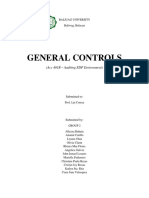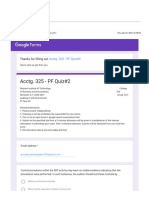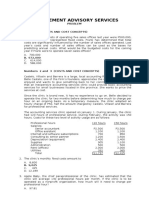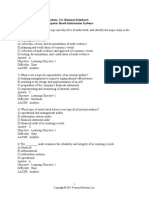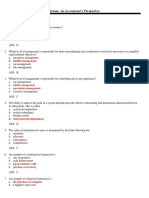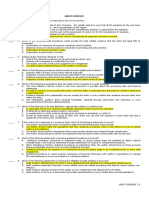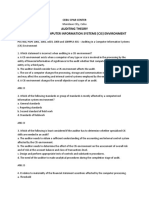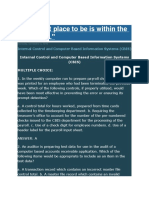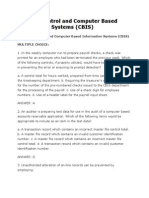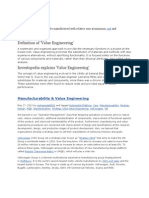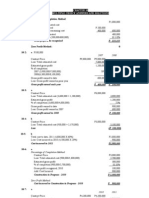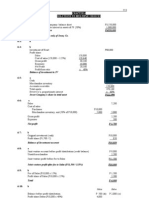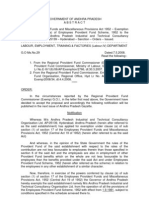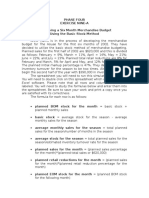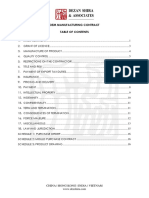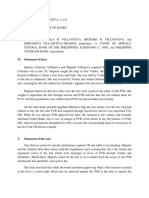CIBS Auditing Theory
CIBS Auditing Theory
Uploaded by
LaraCopyright:
Available Formats
CIBS Auditing Theory
CIBS Auditing Theory
Uploaded by
LaraOriginal Description:
Original Title
Copyright
Available Formats
Share this document
Did you find this document useful?
Is this content inappropriate?
Copyright:
Available Formats
CIBS Auditing Theory
CIBS Auditing Theory
Uploaded by
LaraCopyright:
Available Formats
Internal Control and Computer Based Information Systems (CBIS) MULTIPLE CHOICE: 1.
In the weekly computer run to prepare payroll checks, a check was printed for an employee who had been terminated the previous week. Which of the following c ontrols, if properly utilized, would have been most effective in preventing the error or ensuring its prompt detection? a. A control total for hours worked, prepared from time cards collected by the t imekeeping department. b. Requiring the treasurer's office to account for the nu mber of the pre-numbered checks issued to the CBIS department for the processing of the payroll. c. Use of a check digit for employee numbers. d. Use of a heade r label for the payroll input sheet. ANSWER: A 2. An auditor is preparing test data for use in the audit of a computer based ac counts receivable application. Which of the following items would be appropriate to include as an item in the test data? a. A transaction record which contains an incorrect master file control total. b . A master file record which contains an invalid customer identification number. c. A master file record which contains an incorrect master file control total. d. A transaction record which contains an invalid customer identification number . ANSWER: D 3. Unauthorized alteration of on-line records can be prevented by employing: a. Key verification. b. Computer sequence checks. c. Computer matching. d. Data base access controls. ANSWER: D 4. In auditing through a computer, the test data method is used by auditors to t est the a. Accuracy of input data. b. Validity of the output. c. Procedures contained wi thin the program. d. Normalcy of distribution of test data. ANSWER: C 5. In the preliminary survey the auditor learns that a department has several mi crocomputers. Which of the following is usually true and should be considered in planning the audit? a. Microcomputers, though small, are capable of processing financial information , and physical security is a control concern. b. Microcomputers are limited to a
pplications such as worksheet generation and do not present a significant audit risk. c. Microcomputers are generally under the control of the data processing d epartment and use the same control features. d. Microcomputers are too small to contain any built-in control features. Therefore, other controls must be relied upon. ANSWER: A 6. The primary reason for internal auditing's involvement in the development of new computer-based sysstems is to: a. Plan post-implementation reviews. b. Promote adequate controls. c. Train auditors in CBIS techniques. d. Reduce overall audit effort. ANSWER: B 7. Which of the following is an advantage of generalized computer audit packages ? a. They are all written in one identical computer language. b. They can be used for audits of clients that use differing CBIS equipment and file formats. c. They have reduced the need for the auditor to study input contr ols for CBIS related procedures. d. Their use can be substituted for a relativel y large part of the required control testing. ANSWER: B 8. Processing simulated file data provides the auditor with information about th e reliability of controls from evidence that exists in simulated files. One of t he techniques involved in this approach makes use of a. Controlled reprocessing. b. Program code checking. c. Printout reviews. d. In tegrated test facility. ANSWER: D 9. Which of the following statements most likely represents a disadvantage for a n entity that keeps microcomputer-prepared data files rather than manually prepa red files? a. It is usually more difficult to detect transposition errors. b. Transactions are usually authorized before they are executed and recorded. c. It is usually e asier for unauthorized persons to access and alter the files. d. Random error as sociated with processing similar transactions in different ways is usually great er. ANSWER: C
10. The possibility of losing a large amount of information stored in computer f iles most likely would be reduced by the use of a. Back-up files b. Check digits c. Completeness tests d. Conversion verification. ANSWER: A 11. An integrated test facility (ITF) would be appropriate when the auditor need s to a. Trace a complex logic path through an application system. b. Verify processing accuracy concurrently with processing. c. Monitor transactions in an application system continuously. d. Verify load mo dule integrity for production programs. ANSWER: B 12. Where computer processing is used in significant accounting applications, in ternal accounting control procedures may be defined by classifying control proce dures into two types: general and a. Administrative. b. Specific. c. Application. d. Authorization. ANSWER: C 13. The increased presence of the microcomputer in the workplace has resulted in an increasing number of persons having access to the computer. A control that i s often used to prevent unauthorized access to sensitive programs is: a. Backup copies of the diskettes. b. Passwords for each of the users. c. Disast er-recovery procedures. d. Record counts of the number of input transactions in a batch being processed. ANSWER: B 14. Checklists, systems development methodology, and staff hiring are examples o f what type of controls? a. Detective. b. Preventive. c. Subjective. d. Corrective. ANSWER: B
15. When an on-line, real-time (OLRT) computer-based processing system is in use , internal control can be strengthened by a. Providing for the separation of duties between keypunching and error listing operations. b. Attaching plastic file protection rings to reels of magnetic tape before new data can be entered on the file. c. Making a validity check of an id entification number before a user can obtain access to the computer files. d. Pr eparing batch totals to provide assurance that file updates are made for the ent ire input. ANSWER: C 16. When auditing "around" the computer, the independent auditor focuses solely upon the source documents and a. Test data. b. CBIS processing. c. Control techniques. d. CBIS output. ANSWER: D
17. One of the features that distinguishes computer processing from manual proce ssing is a. Computer processing virtually eliminates the occurrence of computational erro r normally associated with manual processing. b. Errors or fraud in computer pro cessing will be detected soon after their occurrences. c. The potential for syst ematic error is ordinarily greater in manual processing than in computerized pro cessing. d. Most computer systems are designed so that transaction trails useful for audi t purposes do not exist. ANSWER: A 18. Given the increasing use of microcomputers as a means for accessing data bas es, along with on-line real-time processing, companies face a serious challenge relating to data security. Which of the following is not an appropriate means fo r meeting this challenge? a. Institute a policy of strict identification and password controls housed in t he computer software that permit only specified individuals to access the comput er files and perform a given function. b. Limit terminals to perform only certain transactions. c. Program software to produce a log of transactions showing date, time, type of transaction, and operator. d. Prohibit the networking of microcomputers and do not permit users to access c entralized data bases.
ANSWER: D 19. What type of computer-based system is characterized by data that are assembl ed from more than one location and records that are updated immediately? a. Microcomputer system. b. Minicomputer system. c. Batch processing system. d. Online real-time system. ANSWER: D 20. Company A has recently converted its manual payroll to a computer-based syst em. Under the old system, employees who had resigned or been terminated were occ asionally kept on the payroll and their checks were claimed and cashed by other employees, in collusion with shop foremen. The controller is concerned that this practice not be allowed to continue under the new system. The best control for preventing this form of "payroll padding" would be to a. Conduct exit interviews with all employees leaving the company, regardless of reason. b. Require foremen to obtain a signed receipt from each employee claiming a payr oll check. c. Require the human resources department to authorize all hires and termination s, and to forward a current computerized list of active employee numbers to payr oll prior to processing. Program the computer to reject inactive employee number s. d. Install time clocks for use by all hourly employees. ANSWER: C 21. Compared to a manual system, a CBIS generally 1. Reduces segregation of duties. 2. Increases segregation of duties. 3. Decreas es manual inspection of processing results. 4. Increases manual inspection of pr ocessing results. a. 1 and 3. b. 1 and 4 c. 2 and 3 d. 2 and 4. ANSWER: A 22. One of the major problems in a CBIS is that incompatible functions may be pe rformed by the same individual. One compensating control for this is the use of a. Echo checks. b. A self-checking digit system. c. Computer generated hash tota ls. d. A computer log. ANSWER: D 23. Which of the following processing controls would be most effective in assist
ing a store manager to ascertain whether the payroll transaction data were proce ssed in their entirety? a. Payroll file header record. b. Transaction identification codes. c. Processin g control totals. d. Programmed exception reporting. ANSWER: C 24. An organizational control over CBIS operations is a. Run-to-run balancing of control totals. b. Check digit verification of unique identifiers. c. Separation of operating and programming functions. d. Maintenan ce of output distribution logs. ANSWER: C 25. Which of the following methods of testing application controls utilizes a ge neralized audit software package prepared by the auditors? a. Parallel simulation. b. Integrated testing facility approach. c. Test data ap proach. d. Exception report tests. ANSWER: A 26. An unauthorized employee took computer printouts from output bins accessible to all employees. A control which would have prevented this occurrence is a. A storage/retention control. b. A spooler file control. c. An output review c ontrol. d. A report distribution control. ANSWER: D 27. Which of the following is a disadvantage of the integrated test facility app roach? a. In establishing fictitious entities, the auditor may be compromising audit in dependence. b. Removing the fictitious transactions from the system is somewhat difficult an d, if not done carefully, may contaminate the client's files. c. ITF is simply an automated version of auditing "around" the computer. d. The auditor may not always have a current copy of the authorized version of t he client's program. ANSWER: B 28. Totals of amounts in computer-record data fields which are not usually added
for other purposes but are used only for data processing control purposes are c alled a. Record totals. b. Hash totals. c. Processing data totals. d. Field totals. ANSWER: B 29. A hash total of employee numbers is part of the input to a payroll master fi le update program. The program compares the hash total to the total computed for transactions applied to the master file. The purpose of this procedure is to: a. Verify that employee numbers are valid. b. Verify that only authorized employ ees are paid. c. Detect errors in payroll calculations. d. Detect the omission o f transaction processing. ANSWER: D 30. Matthews Corp. has changed from a system of recording time worked on clock c ards to a computerized payroll system in which employees record time in and out with magnetic cards. The CBIS automatically updates all payroll records. Because of this change a. A generalized computer audit program must be used. b. Part of the audit trail is altered. c. The potential for payroll related fraud is diminished. d. Transa ctions must be processed in batches. ANSWER: B 31. Generalized audit software is of primary interest to the auditor in terms of its capability to a. Access information stored on computer files. b. Select a sample of items for testing. c. Evaluate sample test results. d. Test the accuracy of the client's c alculations. ANSWER: A 32. An accounts payable program posted a payable to a vendor not included in the on-line vendor master file. A control which would prevent this error is a a. Validity check. b. Range check. c. Reasonableness test. d. Parity check. ANSWER: A 33. In a computerized sales processing system, which of the following controls i s most effective in preventing sales invoice pricing errors? a. Sales invoices are reviewed by the product managers before being mailed to cu stomers.
b. Current sales prices are stored in the computer, and, as stock numbers are en tered from sales orders, the computer automatically prices the orders. c. Sales prices, as well as product numbers, are entered as sales orders are ent ered at remote terminal locations. d. Sales prices are reviewed and updated on a quarterly basis. ANSWER: B 34. Which of the following is likely to be of least importance to an auditor in reviewing the internal control in a company with a CBIS? a. The segregation of duties within the data processing center. b. The control over source documents. c. The documentation maintained for accoun ting applications. d. The cost/benefit ratio of data processing operations. ANSWER: D 35. For the accounting system of Acme Company, the amounts of cash disbursements entered into an CBIS terminal are transmitted to the computer that immediately transmits the amounts back to the terminal for display on the terminal screen. T his display enables the operator to a. Establish the validity of the account number. b. Verify the amount was entere d accurately. c. Verify the authorization of the disbursement. d. Prevent the ov erpayment of the account. ANSWER: B 36. Which of the following audit techniques most likely would provide an auditor with the most assurance about the effectiveness of the operation of an internal control procedure? a. Inquiry of client personnel. b. Recomputation of account balance amounts. c. Observation of client personnel. d. Confirmation with outside parties. ANSWER: C 37. Adequate technical training and proficiency as an auditor encompasses an abi lity to understand a CBIS sufficiently to identify and evaluate a. The processing and imparting of information. b. Essential accounting control features. c. All accounting control features. d. The degree to which programming conforms with application of generally accepted accounting principles. ANSWER: B
38. Which of the following is not a major reason why an accounting audit trail s hould be maintained for a computer system? a. Query answering. b. Deterrent to fraud. c. Monitoring purposes. d. Analytical review. ANSWER: D 39. Adequate control over access to data processing is required to a. Prevent improper use or manipulation of data files and programs. b. Ensure th at only console operators have access to program documentation. c. Minimize the need for backup data files. d. Ensure that hardware controls are operating effec tively and as designed by the computer manufacturer. ANSWER: A 40. When testing a computerized accounting system, which of the following is not true of the test data approach? a. The test data need consist of only those valid and invalid conditions in whic h the auditor is interested. b. Only one transaction of each type need be tested . c. Test data are processed by the client's computer programs under the auditor 's control. d. The test data must consist of all possible valid and invalid cond itions. ANSWER: D 41. In studying a client's internal controls, an auditor must be able to disting uish between prevention controls and detection controls. Of the following data p rocessing controls, which is the best detection control? a. Use of data encryption techniques. b. Review of machine utilization logs. c. Policy requiring password security. d. Backup and recovery procedure. ANSWER: B 42. Which of the following procedures is an example of auditing "around" the com puter? a. The auditor traces adding machine tapes of sales order batch totals to a computer printout of the sales journal. b. The auditor develops a set of hypothetical sales transactions and, using the client's computer program,
enters the transactions into the system and observes the processing flow. c. The auditor enters hypothetical transactions into the client's processing system during client processing of live" data. d. The auditor observes client personnel as they process the biweekly payroll. T he auditor is primarily concerned with computer rejection of data that fails to meet reasonableness limits. ANSWER: A 43. Auditing by testing the input and output of a computer-based system instead of the computer program itself will a. Not detect program errors which do not show up in the output sampled. b. Dete ct all program errors, regardless of the nature of the output. c. Provide the au ditor with the same type of evidence. d. Not provide the auditor with confidence in the results of the auditing procedures. ANSWER: A 44. Which of the following is an acknowledged risk of using test data when audit ing CBIS records? a. The test data may not include all possible types of transactions. b. The comp uter may not process a simulated transaction in the same way it would an identic al actual transaction. c. The method cannot be used with simulated master record s. d. Test data may be useful in verifying the correctness of account balances, but not in determining the presence of processing controls. ANSWER: A 45. When the auditor encounters sophisticated computer-based systems, he or she may need to modify the audit approach. Of the following conditions, which one is not a valid reason for modifying the audit approach? a. More advanced computer systems produce less documentation, thus reducing the visibility of the audit trail. b. In complex comuter-based systems, computer verification of data at the point of input replaces the manual verification found in less sophisticated data proce ssing systems. c. Integrated data processing has replaced the more traditional separation of du
ties that existed in manual and batch processing systems. d. Real-time processing of transactions has enabled the auditor to concentrate l ess on the completeness assertion. ANSWER: D 46. If a control total were to be computed on each of the following data items, which would best be identified as a hash total for a payroll CBIS application? a. Net pay. b. Department numbers. c. Hours worked. d. Total debits and total cr edits. ANSWER: B 47. In a distributed data base (DDB) environment, control tests for access contr ol administration can be designed which focus on a. Reconciliation of batch control totals. b. Examination of logged activity. c. Prohibition of random access. d. Analysis of system generated core dumps. ANSWER: B 48. A control to verify that the dollar amounts for all debits and credits for i ncoming transactions are posted to a receivables master file is the: a. Generation number check. b. Master reference check. c. Hash total. d. Control total. ANSWER: D 49. The program flowcharting symbol representing a decision is a a. Triangle. b. Circle. c. Rectangle. d. Diamond. ANSWER: D 50. An update program for bank account balances calculates check digits for acco unt numbers. This is an example of a. An input control. b. A file management control. c. Access control. d. An outp ut control. ANSWER: A 51. CBIS controls are frequently classified as to general controls and applicati on controls. Which of the following is an example of an application control?
a. Programmers may access the computer only for testing and "debugging" programs . b. All program changes must be fully documented and approved by the information systems manager and the user department authorizing the change. c. A separate data control group is responsible for distributing output, and als o compares input and output on a test basis. d. In processing sales orders, the computer compares customer and product number s with internally stored lists. ANSWER: D 52. After a preliminary phase of the review of a client's CBIS controls, an audi tor may decide not to perform further tests related to the control procedures wi thin the CBIS portion of the client's internal control system. Which of the foll owing would not be a valid reason for choosing to omit further testing? a. The auditor wishes to further reduce assessed risk. b. The controls duplicate operative controls existing elsewhere in the system. c. There appear to be majo r weaknesses that would preclude reliance on the stated procedures. d. The time and dollar costs of testing exceed the time and dollar savings in substantive te sting if the controls are tested for compliance. ANSWER: A 53. For good internal control over computer program changes, a policy should be established requiring that a. The programmer designing the change adequately test the revised program. b. A ll program changes be supervised by the CBIS control group. c. Superseded portio ns of programs be deleted from the program run manual to avoid confusion. d. All proposed changes be approved in writing by a responsible individual. ANSWER: D 54. Which of the following is not a technique for testing data processing contro ls? a. The auditor develops a set of payroll test data that contain numerous errors. The auditor plans to enter these transactions into the client's system and obse rve whether the computer detects and properly responds to the error conditions. b. The auditor utilizes the computer to randomly select customer accounts for co nfirmation. c. The auditor creates a set of fictitious customer accounts and introduces hypothetical sales transactions, as well as sales returns and allowances, simultaneously with the c lient's live data processing. d. At the auditor's request, the client has modified its payroll processing prog
ram so as to separately record any weekly payroll entry consisting of 60 hours o r more. These separately recorded ("marked") entries are locked into the system and are available only to the auditor. ANSWER: B 55. Which of the following would lessen internal control in a CBIS? a. The computer librarian maintains custody of computer program instructions and detailed listings. b. Computer operators have access to operator instructions a nd detailed program listings. c. The control group is solely responsible for the distribution of all computer output. d. Computer programmers write and debug programs which perform routines designed by the systems analyst. ANSWER: B 56. Access control in an on-line CBIS can best be provided in most circumstances by a. An adequate librarianship function controlling access to files. b. A label af fixed to the outside of a file medium holder that identifies the contents. c. Ba tch processing of all input through a centralized, well-guarded facility. d. Use r and terminal identification controls, such as passwords. ANSWER: D 57. While entering data into a cash receipts transaction file, an employee trans posed two numbers in a customer code. Which of the following controls could prev ent input of this type of error? a. Sequence check. b. Record check. c. Self-checking digit. d. Field-size check. ANSWER: C 58. What is the computer process called when data processing is performed concur rently with a particular activity and the results are available soon enough to i nfluence the particular course of action being taken or the decision being made? a. Batch processing. b. Real time processing. c. Integrated data processing. d. Random access processing. ANSWER: B 59. Reconciling processing control totals is an example of a. An input control. b. An output control. c. A processing control. d. A file ma nagement control.
ANSWER: B 60. A disadvantage of auditing around the computer is that it a. Permits no assessment of actual processing. b. Requires highly skilled audito rs. c. Demands intensive use of machine resources. d. Interacts actively with au ditee applications. ANSWER: A 61. The completeness of computer-generated sales figures can be tested by compar ing the number of items listed on the daily sales report with the number of item s billed on the actual invoices. This process uses a. Check digits. b. Control totals. c. Validity tests. d. Process tracing data. ANSWER: B 62. Which of the following controls would be most efficient in reducing common d ata input errors? a. Keystroke verification. b. A set of well-designed edit checks. c. Balancing a nd reconciliation. d. Batch totals. ANSWER: B 63. On-line real-time systems and electronic data interchange systems have the a dvantages of providing more timely information and reducing the quantity of docu ments associated with less automated systems. The advantages, however, may creat e some problems for the auditor. Which of the following characteristics of these systems does not create an audit problem? a. The lack of traditional documentation of transactions creates a need for grea ter attention to programmed controls at the point of transaction input. b. Hard copy may not be retained by the client for long periods of time, thereby necessitating more frequent visits by the auditor. c. Control testing may be more difficult given the increased vulnerability of th e client's files to destruction during the testing process. d. Consistent on-line processing of recurring data increases the incidence of er rors. ANSWER: D 64. Creating simulated transactions that are processed through a system to gener ate results that are compared with predetermined results, is an auditing procedu re referred to as
a. Desk checking. b. Use of test data. c. Completing outstanding jobs. d. Parall el simulation. ANSWER: B 65. To obtain evidential matter about control risk, an auditor ordinarily select s tests from a variety of techniques, including a. Analysis. b. Confirmations. c. Reprocessing. d. Comparison. ANSWER: C 66. A major exposure associated with the rapidly expanding use of microcomputers is the absence of: a. Adequate size of main memory and disk storage. b. Compatible operating system s. c. Formalized procedures for purchase justification. d. Physical, data file, and program security. ANSWER: D 67. To ensure that goods received are the same as those shown on the purchase in voice, a computerized system should: a. Match selected fields of the purchase invoice to goods received. b. Maintain control totals of inventory value. c. Calculate batch totals for each input. d. Use check digits in account numbers. ANSWER: A 68. Errors in data processed in a batch computer system may not be detected imme diately because a. Transaction trails in a batch system are available only for a limited period of time. b. There are time delays in processing transa ctions in a batch system. c. Errors in some transactions cause rejection of other transactions in the batc h. d. Random errors are more likely in a batch system than in an on-line system. ANSWER: B 69. Which of the following is a computer test made to ascertain whether a given characteristic belongs to the group? a. Parity check. b. Validity check. c. Echo check. d. Limit check.
ANSWER: B
COMPLETION: 70. Although computerized data processing does not affect audit objectives, the auditor may need to modify the audit , given complex CBIS applications. ANSWER: APPROACH 71. In a batch processing system transactions are processed in groups, whereas i n a real-time system transactions are entered as they and are processed as they are . ANSWER: OCCUR, ENTERED 72. Although powerful in terms of , real- time systems are more than batch proce ssing systems. ANSWER: INFORMATION CAPABILITY, COMPLEX 73. A distinguishing feature of integrated data base systems is that many files are updated as transactions are processed. ANSWER: SIMULTANEOUSLY 74. systems, by eliminating the need to reenter data into the accounting system, reduce the incidence of processing errors; but, by reducing transaction documen tation, these systems also require greater attention to proper controls over the of transactions. ANSWER: ELECTRONIC DATA INTERCHANGE, INPUT 75. Input controls, processing controls, and output controls are categories of c ontrols. ANSWER: APPLICATION 76. Some entities require completing a prior to transaction input, in order to e
nsure consistency and completeness of recurring inputs. ANSWER: TRANSACTION LOG 77. are manual control procedures applied by organizational units whose data are processed by data processing. ANSWER: USER CONTROLS 78. In on-line real-time systems the most effective means for assuring limited a ccess to data bases is by the use of properly controlled . ANSWER: PASSWORDS 79. Programmed controls for testing the validity of customer numbers, product nu mbers, employee numbers, and vendor numbers, as well as tests for reasonableness , are collectively referred to as controls. ANSWER: INPUT EDITING 80. In a ____________ __________ system, users own their own data, whereas in _________ ______ systems, users share a single operating system housed in a central location. ANSWER: FLAT FILE, MULTI-USER MATCHING: 81. Indicate by letter whether each of the listed auditing procedures is a gener al control test, an application control test, or a substantive audit test. G = General control test A = Application control test S = Substantive audit test __A__1. The auditor utilizes the services of the firm s computer audit specialist assist in testing controls over the electronic processing of cu stomer remittances. __A__2. In testing the sales processing set of controls, the auditor has designed a set of transactions that include
unauthorized sales prices, invalid customer numbers, and lack of credit authorization. __G__3. The auditor interviews the client s information systems manager to clear exceptions detected when the auditor reviewed data processing job descriptions for incompatible functions. __S__4. The auditor confirmed a sample of customer accounts receivable to evaluate the correctness of year-end balances in customer accounts . __A__5. Using generalized audit software, the auditor reprocessed a sample of the client s weekly payroll and compared the resulting output with the client s payroll summary for the same period. _G___6. The auditor attempted to access the client s computerized data files using the passwords of terminated employees. __S__7. By examining vendors invoices supporting debits to the
account Machinery and Equipment, the auditor was able to gain satisfaction as to the account balance at year end. __G__8. The auditor examined authorizations and studied documentation relating to CBIS modifications made by the client during the year under audit. __G__9. The auditor examined and tested the client s anti virus software for effectiveness. __G__10. The auditor examined printouts from network monitoring software and observed data input for proper functioning of protocol controls and data encryption.
You might also like
- Brealey. Myers. Allen Chapter 16 TestDocument11 pagesBrealey. Myers. Allen Chapter 16 Testcasey222100% (2)
- Manila MAY 5, 2022 Preweek Material: Management Advisory ServicesDocument25 pagesManila MAY 5, 2022 Preweek Material: Management Advisory ServicesJoris YapNo ratings yet
- Auditing Theory Cpa Review Auditing in A Cis (It) EnvironmentDocument11 pagesAuditing Theory Cpa Review Auditing in A Cis (It) EnvironmentJohn RosalesNo ratings yet
- General and Application ControlsDocument8 pagesGeneral and Application ControlsAnamir Bello CarilloNo ratings yet
- Chapter 1-The Information System: An Accountant's PerspectiveDocument100 pagesChapter 1-The Information System: An Accountant's PerspectiveCieloNo ratings yet
- Costco Case StudyDocument7 pagesCostco Case Studymusangz8110No ratings yet
- Aud 7 8 HakdogDocument21 pagesAud 7 8 HakdogPerla ManalangNo ratings yet
- Audit in Cis EnvironmentDocument9 pagesAudit in Cis EnvironmentJewel Mae MercadoNo ratings yet
- Computerized Environment CIS Midterm Review 2022Document26 pagesComputerized Environment CIS Midterm Review 2022Ma. Alene MagdaraogNo ratings yet
- Department of Accountancy: Prepared By: Mohammad Muariff S. Balang, CPA, Second Semester, AY 2012-2013Document8 pagesDepartment of Accountancy: Prepared By: Mohammad Muariff S. Balang, CPA, Second Semester, AY 2012-2013Jaliyah IslaNo ratings yet
- General Controls: (Acc 401B - Auditing EDP Environment)Document9 pagesGeneral Controls: (Acc 401B - Auditing EDP Environment)Pines MacapagalNo ratings yet
- Auditing in CIS Midter Exam QuestionsDocument3 pagesAuditing in CIS Midter Exam QuestionswmcapunoNo ratings yet
- Quiz On Chapter 17: Ul-College of Accountancy Csc42: Auditing in A Cis EnvironmentDocument5 pagesQuiz On Chapter 17: Ul-College of Accountancy Csc42: Auditing in A Cis EnvironmentSyra SorianoNo ratings yet
- Acctg. 325 - PF Quiz#2Document6 pagesAcctg. 325 - PF Quiz#2JoyluxxiNo ratings yet
- Consideration of Internal Control in An Information Technology EnvironmentDocument11 pagesConsideration of Internal Control in An Information Technology EnvironmentYenelyn Apistar CambarijanNo ratings yet
- MAS Quizzers Problems and Theories (Special Handouts)Document62 pagesMAS Quizzers Problems and Theories (Special Handouts)RodNo ratings yet
- Auditing Computer-Based Information SystemsDocument25 pagesAuditing Computer-Based Information SystemsSam SmithNo ratings yet
- 05GeneralInternalControl NotesDocument5 pages05GeneralInternalControl Notesjhaeus enajNo ratings yet
- At.02 Introduction To Audit of Historical Financial InformationDocument4 pagesAt.02 Introduction To Audit of Historical Financial InformationAngelica Sanchez de VeraNo ratings yet
- Auditing in CISDocument11 pagesAuditing in CISCoco Belarmino0% (2)
- AT Quizzer 4 (Audit Documentation)Document5 pagesAT Quizzer 4 (Audit Documentation)JimmyChaoNo ratings yet
- Cpa Review School of The Philippines ManilaDocument2 pagesCpa Review School of The Philippines ManilaJoyce Anne DugayNo ratings yet
- 02 Audit of Mining Entities PDFDocument12 pages02 Audit of Mining Entities PDFelaine piliNo ratings yet
- Aud. in Cis Env. Final Exam 2nd Sem Ay2017-18 (Sam)Document9 pagesAud. in Cis Env. Final Exam 2nd Sem Ay2017-18 (Sam)Uy SamuelNo ratings yet
- D.) Precision: 9. Which of The Following Is NOT An Objective of All Information Systems?Document6 pagesD.) Precision: 9. Which of The Following Is NOT An Objective of All Information Systems?Raisa GermanNo ratings yet
- AIS With AnsDocument84 pagesAIS With AnsCieloNo ratings yet
- Audit Evidence Multiple ChoiceDocument6 pagesAudit Evidence Multiple Choicerandom17341100% (2)
- AIS Midtern Exam AnswerDocument2 pagesAIS Midtern Exam AnswerWen CapunoNo ratings yet
- Quiz Production CycleDocument2 pagesQuiz Production CycleAira Jaimee GonzalesNo ratings yet
- Cisa Test Bank Part 1Document2 pagesCisa Test Bank Part 1JEP WalwalNo ratings yet
- Final Output in AudciseDocument4 pagesFinal Output in AudciseKean Brean GallosNo ratings yet
- PrE5 - Auditing in A CIS EnvironmentDocument14 pagesPrE5 - Auditing in A CIS EnvironmentGlynnis EscobarNo ratings yet
- At Preweek (Part 2) FinalDocument17 pagesAt Preweek (Part 2) FinalJane Michelle EmanNo ratings yet
- Quiz 3 - Final (With Answers)Document9 pagesQuiz 3 - Final (With Answers)OwlHeadNo ratings yet
- AUDITINGDocument20 pagesAUDITINGAngelieNo ratings yet
- Chapter 10 Audit ReportsDocument7 pagesChapter 10 Audit ReportsSteffany RoqueNo ratings yet
- Auditing in A Computer Information SystemsDocument21 pagesAuditing in A Computer Information Systemsadrian ebora100% (1)
- PFRS 6 Acc For Exploration and Evaluating of Natural ResourcesDocument2 pagesPFRS 6 Acc For Exploration and Evaluating of Natural ResourcesElaiza Jane CruzNo ratings yet
- Quiz 1 AuditingDocument1 pageQuiz 1 AuditingSashaNo ratings yet
- Auditing Theory Auditing in A Computer Information Systems (Cis) EnvironmentDocument32 pagesAuditing Theory Auditing in A Computer Information Systems (Cis) EnvironmentMajoy BantocNo ratings yet
- Reviewer For Liabilities and Substantive Test of LiabilitiesDocument4 pagesReviewer For Liabilities and Substantive Test of LiabilitiesErica FlorentinoNo ratings yet
- QUIZ-Audit Evidence and Audit ProgramsDocument12 pagesQUIZ-Audit Evidence and Audit ProgramsKathleenNo ratings yet
- Computer-Assisted Audit Tools and Techniques ApplicationDocument28 pagesComputer-Assisted Audit Tools and Techniques ApplicationGelyn RaguinNo ratings yet
- Specialized BusinessDocument16 pagesSpecialized BusinessMaritess LobrigoNo ratings yet
- AC09302 Expenditure Cycle Part II QuizDocument11 pagesAC09302 Expenditure Cycle Part II Quizkurai_hana11No ratings yet
- Auditing in CIS EnvironmentDocument14 pagesAuditing in CIS EnvironmentLino GumpalNo ratings yet
- Simulated Exam 1Document28 pagesSimulated Exam 1Erin CruzNo ratings yet
- 29 - Liabilities - TheoryDocument5 pages29 - Liabilities - Theoryjaymark canayaNo ratings yet
- Chapter 1 - QuizDocument4 pagesChapter 1 - QuizPersephoneeeiNo ratings yet
- Chapter 21 Internal, Operational, and Compliance Auditing: True/False QuestionsDocument13 pagesChapter 21 Internal, Operational, and Compliance Auditing: True/False QuestionsRNo ratings yet
- CHAP 9. Materiality and RiskDocument28 pagesCHAP 9. Materiality and RiskNoroNo ratings yet
- Chapter 3 CISDocument20 pagesChapter 3 CISGwen Sula Lacanilao100% (1)
- Chapter 12 Computer Audit (I) Multiple Choice QuestionsDocument16 pagesChapter 12 Computer Audit (I) Multiple Choice QuestionsDecereen Pineda RodriguezaNo ratings yet
- Ac-Aud 3Document10 pagesAc-Aud 3Mark Anthony TibuleNo ratings yet
- Data Structures and Caatts For Data ExtractionDocument33 pagesData Structures and Caatts For Data Extractionmary aligmayoNo ratings yet
- AT L. R. Cabarles/J.M. D. Maglinao Quiz 3 SET A OCTOBER 2019Document2 pagesAT L. R. Cabarles/J.M. D. Maglinao Quiz 3 SET A OCTOBER 2019Paula VillarubiaNo ratings yet
- Psa 401Document5 pagesPsa 401novyNo ratings yet
- At 04 Auditing in A Cis EnvironmentDocument16 pagesAt 04 Auditing in A Cis Environmentcarl fuerzas100% (1)
- QUIZ 3 InfoDocument32 pagesQUIZ 3 InfoweqweqwNo ratings yet
- Internal Control and Computer Based Information Systems (CBIS) Multiple ChoiceDocument11 pagesInternal Control and Computer Based Information Systems (CBIS) Multiple ChoiceAnonymous N9dx4ATEghNo ratings yet
- Internal Control and Computer Based Information SystemsDocument28 pagesInternal Control and Computer Based Information SystemsAid BolanioNo ratings yet
- ch08 - Internal Control and Computer Based InformationDocument23 pagesch08 - Internal Control and Computer Based InformationMJ YaconNo ratings yet
- Definition of 'Value Engineering': Cost ReliabilityDocument11 pagesDefinition of 'Value Engineering': Cost ReliabilityLaraNo ratings yet
- B. Sales Less Variable: Absorption CostingDocument3 pagesB. Sales Less Variable: Absorption CostingLaraNo ratings yet
- Variable Costing vs. Absorption CostingDocument3 pagesVariable Costing vs. Absorption CostingLaraNo ratings yet
- Chapter 006 - Valuing Stocks: FalseDocument5 pagesChapter 006 - Valuing Stocks: FalseLaraNo ratings yet
- Reconciliation: Responsibility Accounting and Transfer Pricing (C. Variable Costing & Segmented Reporting)Document2 pagesReconciliation: Responsibility Accounting and Transfer Pricing (C. Variable Costing & Segmented Reporting)LaraNo ratings yet
- Management Representation Letter: If Required Add "On Behalf of The Board of Directors (Or Similar Body) ."Document1 pageManagement Representation Letter: If Required Add "On Behalf of The Board of Directors (Or Similar Body) ."LaraNo ratings yet
- Multiple Choice Answers and SolutionsDocument11 pagesMultiple Choice Answers and SolutionsLaraNo ratings yet
- Chapter 005 - Valuing BondsDocument6 pagesChapter 005 - Valuing BondsLaraNo ratings yet
- Multiple Choice Answers and SolutionsDocument11 pagesMultiple Choice Answers and SolutionsLaraNo ratings yet
- Chapter 005 - Valuing Bonds: True / False QuestionsDocument12 pagesChapter 005 - Valuing Bonds: True / False QuestionsLaraNo ratings yet
- Chapter 7Document18 pagesChapter 7143incomeNo ratings yet
- AsfasfDocument2 pagesAsfasfLaraNo ratings yet
- Chapter 2Document27 pagesChapter 2Mary MarieNo ratings yet
- Joint Venture 113: Solutions To Multiple ChoicesDocument3 pagesJoint Venture 113: Solutions To Multiple ChoicesLaraNo ratings yet
- Environmental Accounting in The Philippines: by Romulo A. Virola, Sylvia M. de Perio and Eduardo T. AngelesDocument27 pagesEnvironmental Accounting in The Philippines: by Romulo A. Virola, Sylvia M. de Perio and Eduardo T. AngelesLaraNo ratings yet
- Multiple Choice Answers and SolutionsDocument12 pagesMultiple Choice Answers and SolutionsLaraNo ratings yet
- Multiple Choice Answers and SolutionsDocument12 pagesMultiple Choice Answers and SolutionsLaraNo ratings yet
- Subramony 2006 GRH OptionsDocument16 pagesSubramony 2006 GRH OptionsMariana MirandaNo ratings yet
- GO MS No.29Document5 pagesGO MS No.29kvjraghunathNo ratings yet
- Revenue Memorandum Circular No. 09-06: January 25, 2006Document5 pagesRevenue Memorandum Circular No. 09-06: January 25, 2006dom0202No ratings yet
- F 706Document31 pagesF 706Bogdan PraščevićNo ratings yet
- P.F03 Rev2Document6 pagesP.F03 Rev2FendiNo ratings yet
- Transport Packing (RTP)Document3 pagesTransport Packing (RTP)piwalNo ratings yet
- Case Analysis of Southwest AirlinesDocument3 pagesCase Analysis of Southwest Airlinesvaishali issraniNo ratings yet
- A Study On The Organisational Behaviour of Aviation IndustryDocument8 pagesA Study On The Organisational Behaviour of Aviation IndustryRoshan BhosaleNo ratings yet
- SAP Introduction To Treasury ApplicationsDocument28 pagesSAP Introduction To Treasury Applicationsfaxmolder100% (1)
- SC Model Case - Dela Cruz v. SantosDocument40 pagesSC Model Case - Dela Cruz v. SantosNethinimsBelieversNo ratings yet
- Strategic Management QuestionsDocument22 pagesStrategic Management QuestionssajithNo ratings yet
- Developing A Six Month Merchandise BudgetDocument4 pagesDeveloping A Six Month Merchandise BudgetIan41198No ratings yet
- Annual Report 2007Document22 pagesAnnual Report 2007Shijo JosephNo ratings yet
- Airtel Marketing MixDocument1 pageAirtel Marketing MixVeni GuptaNo ratings yet
- OEM ContractDocument17 pagesOEM Contractdiazgeboy212No ratings yet
- Asq 2012Document2 pagesAsq 2012baniruther7746No ratings yet
- ITP Fire Hydrant Installation Testing CommissioningDocument1 pageITP Fire Hydrant Installation Testing CommissioningowissghalebNo ratings yet
- Kerala State Entrepreneur Development Mission (Ksedm) General Instructions Eligibility CriteriaDocument2 pagesKerala State Entrepreneur Development Mission (Ksedm) General Instructions Eligibility CriteriabinilzalkarNo ratings yet
- CHEERS 2022 Checklist 1Document3 pagesCHEERS 2022 Checklist 1Husnul QarinaNo ratings yet
- ESCAPE Penang Team BuildingDocument7 pagesESCAPE Penang Team BuildingigclearnNo ratings yet
- Tata Case StudyDocument18 pagesTata Case StudyRanjan BhagatNo ratings yet
- RV ICE S: Krishna Sales & ServicesDocument1 pageRV ICE S: Krishna Sales & ServicesSaikatNo ratings yet
- Process Output Types Through ProgramDocument2 pagesProcess Output Types Through ProgramKarunGaurNo ratings yet
- Executive SummaryDocument4 pagesExecutive SummaryPatricia DasecoNo ratings yet
- C. Brewer and Co., Ltd. v. Marine Indemnity Ins. Co. of America, No. SCWC-28958 (Haw. Mar. 27, 2015)Document28 pagesC. Brewer and Co., Ltd. v. Marine Indemnity Ins. Co. of America, No. SCWC-28958 (Haw. Mar. 27, 2015)RHTNo ratings yet
- Villanueva Vs CADocument3 pagesVillanueva Vs CACharlotteNo ratings yet
- Classified 2014 12 01 000000Document6 pagesClassified 2014 12 01 000000sasikalaNo ratings yet
- Problem Solving Week 2Document2 pagesProblem Solving Week 2Ahmed RaeisiNo ratings yet










